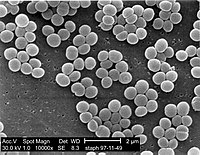
Photo from wikipedia
Staphylococcus spp. colonize commensally on the human skin. Some commensal coagulase-negative staphylococci and Staphylococcus aureus are also involved in nosocomial infections. Bacteria were collected from skin healed from pressure injury… Click to show full abstract
Staphylococcus spp. colonize commensally on the human skin. Some commensal coagulase-negative staphylococci and Staphylococcus aureus are also involved in nosocomial infections. Bacteria were collected from skin healed from pressure injury (PI). After the collection time points, some patients suffered from recurrent PI (RPI). This study analyzed the characteristics of Staphylococcus spp. on healed skin before recurrence between healed skin that suffered from RPI within 6 weeks (RPI group) and healed skin that did not suffer within the duration (non-RPI group) by Staphylococcus spp.-specific sequencing. Of the seven patients in the RPI group, two were dominated by S. aureus and four by Staphylococcus caprae, coagulase-negative human commensal staphylococci in the RPI group. Using mouse models, both S. caprae and S. aureus, but not Staphylococcus epidermidis, colonized on skin healed from injury at significantly higher rates than normal skin. Although subcutaneous injection of S. caprae did not induce lesion formation, the bacterium exhibited high hemolytic activity on human red blood cells. Lesion formation by subcutaneous injection of S. aureus was significantly suppressed in the presence of S. caprae. The hemolytic activity of rabbit blood cells of S. aureus was suppressed by S. caprae, whereas the hemolytic activity of S. caprae was dramatically suppressed by S. aureus. Data indicated that each of the two Staphylococcus spp. suppresses the pathogenicity of the other and that the imbalance between the two is associated with RPI.
Journal Title: Frontiers in Microbiology
Year Published: 2022
Link to full text (if available)
Share on Social Media: Sign Up to like & get
recommendations!